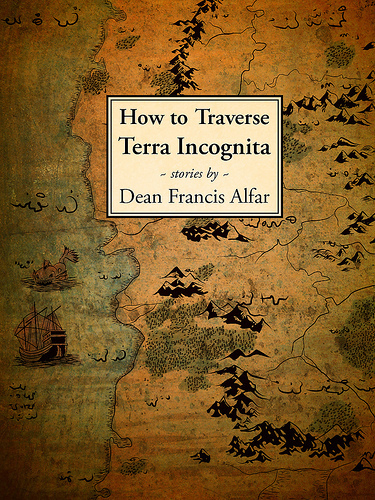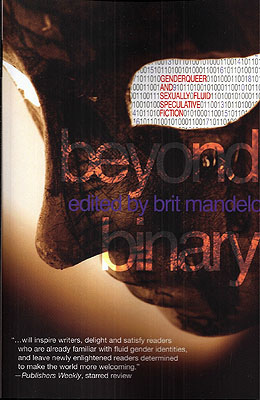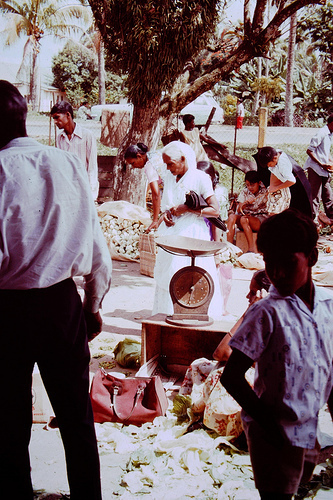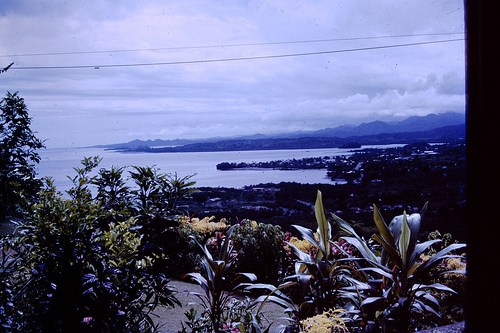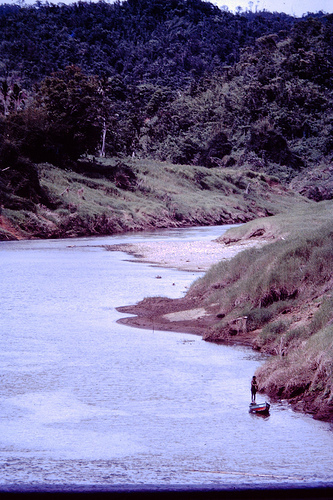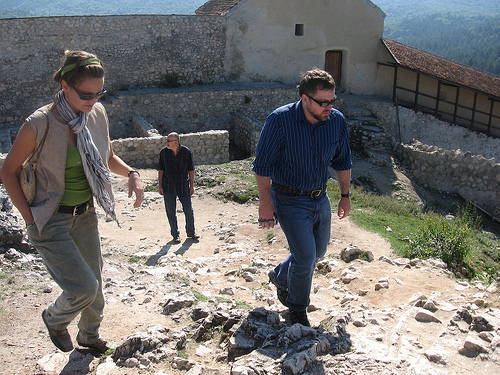Jeff VanderMeer's Blog, page 25
August 31, 2012
Book Murderer Excerpt for Hal Duncan’s Storybusking
Hal Duncan, the juggernaut responsible for Ink and Vellum, is storybusking. –he’s a great writer. And in solidarity with him, here’s an excerpt from a novel I’m working on, The Book Murderer. If you like what you read, go donate something to Hal.
On one of his most recent missions, the Book Murderer had driven inland to a local community college, to steal the novel rough draft and notes from an old mole of a professor. The Book Murderer called this practice “source-snuffing.” Of late, the Book Murderer wanted more and more to see his nemesis in its pre-natal, natal, and juvenile forms. To better understand, that he might destroy faster and more furiously, and perhaps one day learn the ancient arts of killing books near the point of conception. It was a dream, but everyone needed something to aspire to.
The Book Murderer called the professor “Linda Hunt” because she resembled a slightly taller version of the actor. Linda Hunt, beloved by her credulous and no doubt illiterate students, had published what many reviewers considered one good novel back in the 1970s, entitled Gormus the Imposter. She had then spent the rest of her life tunneling through the dirt, blind and querulous. The Book Murderer had read about the professor in the city’s weekly rag, a broadsheet of no particular reputation that he held by the corners to avoid the noxious ink. “For the past twenty-five years, amongst some false-starts, I have been working on a new novel entitled Sojourns Amongst the Blind Men of the Interior.” The reporter noted that the manuscript was some 2,000 pages thus far and a photograph confirmed this fact, showing the professor sitting at her desk nearly devoured by the stack of pages upon her blotter. The manuscript clearly had many revisions scrawled upon its pages, and Linda Hunt admitted ruefully that she had not had time to create a copy of her changes.
The heist itself went well—ski mask to project his identity; dull time on campus with most students away; professor out of his office; quick lock-pick—but things became more complicated in the parking lot. Linda Hunt, showing an unexpected proclivity for both detective work and quick action (or perhaps it was luck) tracked the Book Murderer down before he could get to his car. There came a sudden explosive curse from his left, and a rush of air indicating something ferocious descending, and a bull rush by the old mole sent the Book Murderer with a surprised oof flying to the ground—”It felt as if a refrigerator had fallen on top of me”—while, as if a dream or a bad movie, the manuscript—bound to an almost mummy-like extent with rubber bands—slowly thudded to the asphalt, skoshing onto one side like a listing ocean liner some seven or eight feet away from him. Driven by some odd instinct that was not self-preservation, the Book Murderer twisted around and leapt upon the manuscript.
Lunging on top of him, the professor rained down all the caged ferocity of fifty badgers upon the Book Murderer, “attempting to beat the living shit out of me,” as the Book Murderer later told the lush named Maria in a grave tone, she with her head plonked down on the bar surface, blonde hair sprawling out over her face. “I struggled hard, but this person was possessed, I tell you, and had the strength of one hundred badgers. Her hands were like huge mallets tenderizing my poor flesh.”
He had had flailed woundedly across his back with his left arm in a feeble attempt to fight back, the other desperate to keep his ski mask on while he bloated out his belly to keep the manuscript safe beneath him. Meanwhile, the professor boxed his ears, pulled the hair on the back of his neck, and punched him in the sides, roaring “No one takes my sojourn away from me! No one! Not a fucking soul! Takes! My! Novel! From! Me! Do you hear?!” The pummeling was, to be honest, as much startling as damaging, but it still hurt and he had no effective defense, nor any way to rise without giving up the manuscript.
After a short while, feeling as if he were in a small boat being buffeted by wind and rising waves, the Book Murderer clenched his stomach, stopped fighting, pulled the manuscript out from under him, and shoved it to the side. “Take it! Take the damn thing if it means so much to you, you asshole,” the Book Murderer said.
The professor, teetering, lifted her manuscript off the asphalt, embraced it, and as now heavily breathing Book Murderer rolled over onto his back spat upon him before stalking off, seemingly as diminutive as ever.
“Don’t you know who I am, Linda Hunt?” the Book Murderer screamed after her, to the amusement of the couple of freshman who were the only ones loitering in the parking lot. “Don’t you know I’m the Book Murderer. And how the fuck did you get so fucking strong?!”
“You could be the goddamn Pope of Siberia and I wouldn’t care!” the professor shouted over her shoulder. “Leave my book alone, you philistine. Ever come back here and I’ll kill you!”
“There are laws against threats in this city! I can have you arrested!” the Book Murderer howled after her, but received no reply.
Wiping off the professor’s spit, pungent with the unexpected stench of chewing tobacco, the Book Murderer made his escape. He suffered an enduring bafflement, however, over the days as his wounds healed and the bruises on the back of his head and sides of his face faded to yellow. The manuscript, from what he’d glimpsed of it on his way out, was awful: turgid, long, and weighed down by a pendulous, too thick ending. Why would the professor care so much about it? At least one person other than the author had read part of it.
“But the worst of it had nothing to do with the book,” the Book Murderer said to the now snoring Maria slumped next to him at the Bullheaded as he downed a shot of Caol Ila, cask strength. This was not information he could share with a conscious person, and he even waited until the bartender had gone in back for more ice and the television was especially blarey with idiot sports. “It came from the feeling I was being watched by some fucking shadow. I had the distinct impression of some asshole staring at me intently from one of the cars. I felt it even more acutely as I drove off, but I could see no one—not even the suggestion of a fart in the breeze. Now, what do you think of that? What, exactly, should I think of that?”
What he did not say is that noticing this shadow, this ghost, this potential eavesdropping fiend, had given him a slight frisson of unexpected energy and curiosity.
This worried the Book Murderer greatly.
Book Murderer Excerpt for Hal Duncan’s Storybusking originally appeared on Ecstatic Days on August 31, 2012.




August 29, 2012
Ann VanderMeer Joins Tor.com Editorial Staff, Acquiring Short Fiction

The news just broke at Tor.com that my wife, Ann VanderMeer, will be consulting fiction editor for the website. Which I believe is among the highest-paying markets in SF/F. She will be acquiring short fiction for Tor.
“She brings a sharp eye for adventurous fiction to all of her projects, and we look forward to the stories and authors she’ll bring to Tor.com.”
This is richly deserved and only poetic or karmic justice in many ways. I’m really thrilled for her!
Ann VanderMeer Joins Tor.com Editorial Staff, Acquiring Short Fiction originally appeared on Ecstatic Days on August 29, 2012.




Dean Francis Alfar: Read New Fiction, Buy His New Collection
Dean Francis Alfar is an excellent short story writer whose second collection How to Traverse Terra Incognita is now available on Amazon and elsewhere in e-book form. The book comes with blurbs from such luminaries as Hugo Award winners Ann VanderMeer and Lynne M. Thomas, among others.
is now available on Amazon and elsewhere in e-book form. The book comes with blurbs from such luminaries as Hugo Award winners Ann VanderMeer and Lynne M. Thomas, among others.
Not familiar with Alfar? Here’s what you need to know.
Alfar is a Filipino playwright, novelist and writer of speculative fiction. His plays have been performed in venues across the country, while his articles and fiction have been published both in his native Philippines and abroad, such as in Strange Horizons, Rabid Transit, The Year’s Best Fantasy and Horror and the Exotic Gothic series. His literary awards include the Don Carlos Palanca Memorial Awards for Literature and then Manila Critics’ Circle National Book Award. He is an advocate of the literature of the fantastic, editing the Philippine Speculative Fiction series, as well as a comic book creator and a blogger. Alfar is also an entrepreneur who runs several businesses. He lives in Manila with his wife, fictionist Nikki Alfar and their two daughters.
So here’s a proposition for you, since I’m a big fan of Alfar’s work. Below the cut, Alfar is allowing me to post “Enkantong-bato,” his entry from the bestiary anthology Ann and I are editing—totally new fiction, not found in the collection, free for you to read. Exclusive to this blog post and only available here for the next month. BUT, if you read and enjoy it, please do me favor and go buy How to Traverse Terra Incognita. The fact is, you’ll actually be doing yourself a favor!
Enkantong-bato
By Dean Francis Alfar
On May 16, 1965, the annual dinner of the Philippine Society for the Advancement of Science was disrupted by the unexpected arrival of Professor Angelo Lim-Diokno, thought to have fallen to Japanese bayonets during the Siege of Manila almost two decades ago. The stunned intelligentsia could only watch as the stooped man, his wrinkled skin the color of dried betel nuts, climbed the short steps up onto the stage and with a trembling voice that belied his age made the following announcement:
“I have found the Enkantong-bato!”
His voice, amplified by the sound system, had barely completed a round of echoes in the hall when he raised his right arm as high as his strength permitted. There in his hand rested what seemed to be a large stone of a startling variety of hues. The harsh light of the stage revealed crystalline formations protruding from the stone-like steps – and as Lim-Diokno extended his hand toward the skeptical audience, the stone moved, flexing its sparkling arms in different directions like a gemstone sea urchin. Whatever else Lim-Diokno had to say was drowned by the spontaneous standing ovation that followed his dramatic presentation and the human wave of scientists that proceeded to envelop him and his precious specimen.
Lim-Diokno’s story of his miraculous escape from the Japanese, the complex series of events that led to his new life as a guerilla on the island of Panay in the Visayan portion of the archipelago, and his subsequent storm-tossed return to the capital, were eclipsed by the excitement elicited by the treasure that he had brought back. What he held in his hands was a living Enkantong-bato (“Enchanted Stone” translated from the Filipino), a creature wrenched from the depths of legend.
In the oral traditions of the Visayan islands from the time of heroes, there are multiple accounts of a living stone whose crystalline protuberances were responsible for a variety of seemingly magical effects: among the most famous stories were those of Banna of the Calingga, who possessed an axe said to be given to him by the gods – its blade was made from the crystals of the Enkantong-bato; Labaw Donggon of the Visayas, who was famous for the Enkantong-bato that bestowed supernatural sight upon him; and Prince Bantugan of the Maranao, whose supernatural servitor Magaw took the form of floating glittering fragments.
Spain, which conquered the archipelago, installed the Christian faith, and held the country for three hundred years, was never able to completely eradicate these wonder tales, despite the best efforts of priests of various orders. Despite conversions and Catholic rituals, Filipinos continued to tell each other the stories of the past age, and the legend of the Enkantong-bato was preserved.
All accounts agree on its appearance, describing the step-like arms that protruded from the stony exterior. Most agree that it was a living creature, similar to the crab or snail, housed by a rocky exterior of surprising beauty. But no one had ever seen one alive.
In 1822, while directing the construction of the Church of the Holy Family in Cavite, Luzon, the Dominican frayle Augusto Ibarra de la Cruz reportedly found a fragment of an Enkantong-bato. According to church records, the specimen consisted of a portion of the stone shell and five crystal arms, the longest of which extended over four inches in length. When the structure was completed a year early, rumors swirled around the area regarding the power of the fragment. When the church authorities came to investigate, however, the specimen had vanished, and frayle Augusto Ibarra de la Cruz along with it.
The Enkantong-bato surfaces next during the Spanish-American war. In the end, the Americans were able to wrest the nation from Spain, but a tragic occurrence during the Battle of Manila Bay at the very start of the war threatened to maintain Spanish sovereignty over the Philippines. On May 1, 1898, the obsolete and undermanned Spanish Pacific Squadron commanded by Admiral Patricio Montojo y Pasarón faced the American Asiatic Squadron under Commodore George Dewey on board the USS Olympia. In column formation, the American warships engaged the Spanish at close range. By the first two cross runs, the Spanish defeat seemed a certainty. However, a sudden explosion below the crew’s quarters rocked the USS Raleigh, one of the vessels under Dewey’s command. The succeeding blast lifted the entire ship out of the water and rained debris for hundreds of yards around. Within minutes, the battleship sank. Dewey quickly assigned the USS Boston to rescue survivors in the water and proceeded to complete three more cross runs, eventually obliterating the Spanish fleet. The explosion that claimed 223 United States sailors remained a mystery to the victorious Americans, but rumors that the Spanish Admiral possessed an Enkantong-bato made the rounds in the liberated capital.
During World War II, when the Japanese invasion forced General Douglas MacArthur and his troops to abandon Corregidor Island and retreat to Australia in PT boats, there were accounts that the Japanese victory over the United States Army Forces in the Far East (USAFFE) was facilitated by their discovery and consequent weaponizing of an Enkantong-bato.
In July 1965, Professor Angelo Lim-Diokno, under intense pressure from the Senate President Ferdinand Marcos, agreed to surrender his prized possession to the government, for “the sake of posterity”. Unknown to Marcos, Lim-Diokno, hearing of the plan to deprive him of the enkantong-bato, convened a small group of scientists and proceeded to surgically examine the creature over several frantic midnight sessions at the Philippine Science Institute in Manila. Their findings were then secreted away, and Marcos was given only the shell of the creature. Lim-Diokno and his colleagues then vanished from the historical records. Marcos, who became the President of the Republic of the Philippines in the same year, was rumored to have used the remains of the creature to perpetuate his wealth and power. It was said to have been the basis for his “hidden treasure”. But all the supposed abilities of the Enkantong-bato could not perpetuate his dictatorship, which ended with the People Power Revolution of 1986. Exiled in Hawaii, Marcos died on September 28, 1989 of various internal ailments.
The scientific record of the Enkantong-bato remained hidden throughout the next decades, surfacing only in September 2010 during the presidency of Benigno Aquino III. Published by the University of the Philippines Press, “Enkantong-bato: Truth” became a national bestseller.
The 1965 findings included the discoveries that the Enkantong-bato shared certain zoological similarities with the Carcinoscorpios rotundicauda, the mangrove horseshoe crab, enough for it to be considered an arthropod. But while both species are protected by a hard shell, the Enkantong-bato’s stony exterior was revealed to be a mix of silicate minerals, combinations of silicon, oxygen and calcium, with the colorful protrusions consisting mostly of bismuth. Samples of its blood tested highly for vanadium instead of iron, explaining the blood’s rich green coloration. The specimen had two large compound eyes and multiple smaller ones atop the exoskeleton, and five pairs of stunted legs behind which rested book gills for exchanging respiratory gases. The scientists noted the existence of a thoracetron in its free abdominal segments. Unlike the horseshoe crab, it possessed no tail.
And unlike its storied history, it indicated no preternatural abilities.
The resurfaced findings did little to diminish the Enkantong-bato’s mystique.
Dean Francis Alfar: Read New Fiction, Buy His New Collection originally appeared on Ecstatic Days on August 29, 2012.




August 28, 2012
Weird Fiction Review Features Finnish Writer Johanna Sinisalo and Much More!
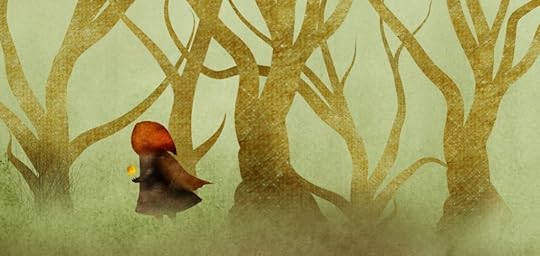
(Art by Jeremy Zerfoss)
It’s been a great few weeks at Weirdfictionreview.com—we’ve been posting a ton of amazing content. This week we’re featuring the Finnish writer Johanna Sinisalo, but also check out wonderful material by Edward Gauvin, Matthew Pridham, Nancy Hightower, and Rochita Loenin-Ruiz. (Many thanks to our managing editor, Adam Mills, for making this all happen.)
An essay on Finnish Weird
A significant section of the people who do not read books in these styles have a surprisingly narrow understanding of what these genres entail. For them, the mere mention of the word ‘fantasy’ conjures up visions of a pseudo-Dark Age world inhabited by fairies, spirits, dwarves and dragons and where people used magic swords to fight against the powers of darkness.
An excerpt from her award-winning novel Troll
In the studio I take Pessi in my arms then whisk the Stalkers on to his back legs with a single pull?—?knowing I’d not manage it at a second shot. If Pessi had thought of spreading his hind claws, the jeans wouldn’t have slipped on: the legs would have been torn to shreds. A size to fit a three-foot-six-inch child suits him stunningly. I’ve got the zip and metal button fastened and have twitched his tail through the hole I’ve made in the Stalker backside before he realizes he’s been diddled. Then I throw Pessi?—?now a hissing, whirling ball bristling with razor-sharp claws?—?in front of the backdrop, and I start the automatic camera rolling.
A new, exclusive interview with the author
If I’m brutally honest, I have to mention Carl Barks and his classic Donald Duck comics. Barks had an enormous talent of entertaining with the tools of exaggeration, mystery, bizarre characters and unlimited?–?sometimes very, very weird?–?imagination. In my honest opinion, Carl Barks was one of the greatest writers of 20th century. I have learned to read leafing through Donald Duck comics, and whenever I encounter some of the old stories I first read when I was four or five, I get goosebumps, because I can still recall the excitement and thrill of the first reading in detail.
Also new on the site:
—Nancy Hightower on the art of Chris Mars
—Edward Gauvin on “Echoes”
—Matthew Pridham on the movie The Last Winter
Did you miss it? Rochita Loenin-Ruiz’s fiction and nonfiction:
Hunting for Stories in the Philippines
One thing I immediately learned was this: horror is alive and well in Filipino language publications. I found tales of hauntings and possessions. Murdered spirits come back to avenge their deaths, beautiful white ladies turn into monsters, and creatures of the night feed on innocent flesh. These stories are familiar to every Filipino, for who doesn’t know of the aswang or the tikbalang? What Filipino is unfamiliar with the kapre and the nuno sa punso? Who hasn’t heard of hauntings and blood dripping down the walls?
Of the Liwat’ang Yawa, the Litok-litok and their Prey
In the same year as Dimaano’s book came out, a series of killings took place in the towns of Kalaygo and Layog. The killings resembled those described in Dimaano’s book, and pushed the book further into the spotlight. His thesis was embraced as canon and became the source book for shows like Guni-guni and Mameng Taleng’s Nightside Tales.
Weird Fiction Review Features Finnish Writer Johanna Sinisalo and Much More! originally appeared on Ecstatic Days on August 28, 2012.
August 27, 2012
Borne: The Balcony Cliffs
Another novel I’ve been working on and hope to finish soon is entitled Borne. Here’s an early section, mostly exposition, that I’m not sure will survive intact in the final novel. Borne is set in a kind of post-collapse city.
My relationship with Wick was complicated by more than our sleeping arrangements. It was defined by where we lived, in the ruins of what I had dubbed the Balcony Cliffs. By the time I found the sea anemone, our fates in that place had become intertwined: Wick provided his biotech and chemical deceptions and I provided my talent for building traps both physical and psychological.
Throughout this warren there now existed allegiances and synergy between Wick’s creations and my traps that felt intimate—more intimate in some ways than the details of our physical relationship. At some point, just as a system of defense had connected, so too had our bodies. Out of what I told myself were extremes of loneliness, we had slept together. Maybe it had started that way, but it had moved beyond comfort into friendship. I had even been known to marvel at the contrast of his pale, almost translucent skin against the brown of my thighs. But even in such intimate moments, Wick could not quite cast off some invisible exoskeleton, some lingering stiffness that put distance between us.
This suited me to some degree; I had always tried to make it clear our fucking wasn’t personal. But the truth is when we were together, I felt connected to him by a series of fiery lines. I was intensely aware of these lines, almost as if wires surged out of my brain, the whole mass of corridors, tunnels, and rooms attached to sensors. Trip wires, too, sensitive to touch and vibration. I did not want to be that connected, but I had no choice.
If I had drawn the Balcony Cliffs on a map, it would have resembled the cut-away of the side of a massive mound, in this case filled with debris, cracked girders, human remains, abandoned refrigerators, fire-bombed or crushed cars…all of it mulched below or nestled within a dense ground cover of half-dirt, half-moss-and loam that had a springy, almost jaunty feel to the tread. New growth of what the generous might call stunted trees crept up through the moss to protect a central copse of tall pines.
An observer might have thought the place a vast midden, but under that weight, within the cross-section of the body that served as our home, the lines connected to a woman named Rachel radiated out to merge with corridors surging back through the mound, some of them dead-ends leading to places where the roof had fallen in from the flotsam pressing down, or where supporting walls decided they had suffered enough neglect. Corridors? Tunnels? The distinction had been lost as I had reinforced or hollowed out the best and left the rest to rot—all long before Wick’s arrival.
One route led to Wick’s rooms, another to the ladder in the lobby that shot up toward a telescope hidden in one of the pine trees above, another to the converted swimming pool that Wick had turned into a seething vat of biotech creations…and closer to the middle, where the lines grew more tangled, my apartment, as if I were some great trapdoor spider. Except my goal was simply to daunt. I was the Great Daunter. I wanted to make any intruder encounter not me but dead ends full of piles of books, a cradle never meant to be broken or sentimental, a few dozen shoes some with feet mummified inside them, the dried-out remains of some snarling dog-like animal that had wandered in, gotten lost, and starved to death in a corner.
From this center, the lines in my head radiated out most urgently to the western edge of the mound, which faced the Company across the great broken divide of the city’s southwest flank, the confusion deliberately multiplied, my purpose to create a maze for the unexpected visitor…before simplifying again at the exit to three passageways, only one of which led anywhere safe, and before that a door that from the outside appeared to just be part of the mound, obscured by the welter of moss and vines. A strong smell of carrion—one of Wick’s distortion pheromones—grew unbearably strong the closer you came to it. Sometimes even I had trouble finding that entrance, as if the smell helped hide its outline.
Wick added special beetles and spiders and other precise infiltration mutations as he called them—so effective that even after the Company had cast him out and he had lost their protections, the strength of rumors alone protected him for a time. These creatures registered in my network of lines as pleasing nodes, unless I was angry with Wick, and then I thought of them as irritating, interfering knots in the system.
Less controllable but also neutral ground: the cliff face itself, the eastern edge of the mound, overlooking the insane river of filth. No special protections applied there—just a veil of something like mosquito netting, nailed in place, that helped disguise us from anyone who might stumble out onto the other balconies to the north that jutted like stone chins. Sometimes we would see people on the balconies farthest away, beyond the perimeter of the mound. Distance always transformed them into tourists come to look at the scenic view.
We knew they were more dangerous than that but sometimes those people helped us pretend for awhile that we did actually live in the exclusive, the swanky, Balcony Cliffs, a place the rich had built so they could have that sunrise, that breathtaking view. In those moments, the lines radiating out from me to the mazes, the traps, the biotech would become thready, more tenuous, and I would sense the risk of relaxing into conversation with Wick and making believe we were just a normal couple in a normal time and place.
Sometimes, as I drifted off to sleep in my apartment, I could feel the solid weight of all the earth and remains of the old world above pressing down. The lines, the wires, would be snuffed out and I would experience a strange kind of comfort.
Wick and I were the last inhabitants of the Balcony Cliffs. Over the past few years before Wick moved in, the foragers and scavengers that had lived on the outer edges of my stronghold had disappeared, been killed, or moved on, leaving me with what some might still call squatter’s rights. I had discouraged Wick from letting any of his underlings take up residence with us.
This, then, is where I had brought my sea anemone that was not a sea anemone—into this cocoon, this safe haven, this sprawling trap that took up vast amounts of our time and resources. We both knew, Wick and I, that no matter how much raw material he generated or bartered for, the beetle parts and other essentials he had stolen would run out. Each day brought us closer to a time when those lines would snap and we would have to redefine our relationship to the place in which we lived and to each other.
Borne: The Balcony Cliffs originally appeared on Ecstatic Days on August 27, 2012.
Brit Mandelo’s Beyond Binary Interview
Over at Omnivoracious.com you’ll find my feature on the excellent anthology Beyond Binary, including quotes from an interview I conducted with editor Brit Mandelo. Go check it out and recommend it to your friends! And below you’ll find Mandelo’s full answers to a couple of the questions; I couldn’t include everything due to length considerations.
What do you think makes SF/F ideal for exploring ideas and issues related to gender and sexual identity?
I think that the astounding range of possibilities speculative fiction offers for asking vital questions, reinterpreting or discarding contemporary mores, and breaking boundaries is what makes it ideal for exploring issues of gender and sexuality. SFF not only allows us to ask “what if?,” it also allows us to make real whatever we can imagine—the very nature of the form, as a literature of extrapolation and invention, opens up a field of discourse where everything has potential and anything is possible. This nearly unlimited ability to explore, expand, and explode definitions makes speculative fiction the only form that can effectively transcend and truly embody an equally vast multitude of potential gender and sexual identities.
In the same vein, Joanna Russ’s argument for speculative fiction is one that resonates with me, too, and I tend to quote it when asked a question like this. She said, “science fiction […] provides myths for dealing with the kind of experiences we are actually having now, instead of the literary myths we have inherited, which only tell us about the kinds of experiences we think we ought to be having.” In SFF, we can deal authentically with issues of identity and self in a way that is often effaced or barred from traditional literary forms; being able to twist and restructure reality in narrative is a powerful tool for social criticism. In fact, I’d say that the tools for social criticism are natural to and almost inseparable from the same narrative machinery that drives speculative fiction to begin with—that willingness to ask questions, to imagine, and to invent worlds that are not quite like our own. Speculative fiction, then, offers a golden opportunity for folks whose stories are often silenced to encompass their narratives, their identities, in a form that is—in a lot of ways, though this is a whole different argument—itself a sort of outsider literature.
I’m curious as to what kinds of effects stripping out gender referents has on fiction, in your opinion?
When done well, it can destabilize narrative assumptions about gender—and, even more so, reader assumptions. When we begin reading a story, we make assumptions based on hints and clues from the narrative, yes, but also based on our own implicit worldview. I’m as guilty of this as anyone; it’s just a way that we make meaning during the reading process. But, when a story manages to sidestep gender referents and craft a narrative not mediated by explicit gender, that’s something special: it forces the reader to step back and check their own assumptions about character gender, and destabilizes the assumption that everyone presents a specific gender. The thematic force of a narrative that rests on an agendered, neutrois or un-gendered person can also be pretty stellar, challenging mythologies of gender performance and the binary of male/female that the English language so commonly subscribes to. (And, on a craft level, writing without gendering a character is a pretty thrilling display of technical mastery. It’s hard to overstate the control and precision required to write, and write well, without pronouns or gendered language.)
Brit Mandelo’s Beyond Binary Interview originally appeared on Ecstatic Days on August 27, 2012.
August 25, 2012
Shriek: We Are Lost–The Church Soundtrack
My 2006 novel Shriek: An Afterword had a soundtrack by the Australian band The Church, and now three of the tracks are on YouTube. I really love what they did with the novel, and the Bannerville one…well, Steve Kilbey did a great job conveying the emotion of that scene—he’s reading from the novel directly. You can buy the CD direct from The Church here.
I’ve got some hardcovers of the novel I need to get out of the house—we’re getting rid of some clutter—so email me at vanderworld@hotmail.com if you want one signed with an illustration. $6 plus $3 shipping anywhere in the US. Anywhere else, query first. This is still the novel I’m most proud of, and the one I keep getting emails about. In fact, one couple told me part of their marriage vows came from Shriek.
Description:
An epic yet personal look at several decades of life, love, and death in the imaginary city of Ambergris–previously chronicled in Jeff VanderMeer’s acclaimed City of Saints & Madmen–Shriek: An Afterword relates the scandalous, heartbreaking, and horrifying secret history of two squabbling siblings and their confidantes, protectors, and enemies.
Narrated with flamboyant intensity and under increasingly urgent conditions by ex-society figure Janice Shriek, this afterword presents a vivid gallery of characters and events, emphasizing the adventures of Janice’s brother Duncan, a historian obsessed with a doomed love affair and a secret that may kill or transform him; a war between rival publishing houses that will change Ambergris forever; and the gray caps, a marginalized people armed with advanced fungal technologies who have been waiting underground for their chance to mold the future of the city.
Part academic treatise, part tell-all biography, after this introduction to the Family Shriek, you’ll never look at history in quite the same way again.
Shriek: We Are Lost–The Church Soundtrack originally appeared on Ecstatic Days on August 25, 2012.




The Book Murderer (excerpt)
For awhile now I’ve been working on a novel entitled The Book Murderer. It’s a strange hybrid in that it has satirical elements (sending up all aspects of book culture) but becomes more and more psychologically three-dimensional as it goes along and you come to know the main character’s background. It probably has a little bit of something to offend everyone. And it’s incredibly sweary, for those who don’t like the sweary… (As readers should know by now, I often write characters I don’t agree with or don’t agree with in all particulars…)
Here’re the opening sections…
1.
If the Book Murderer had stopped long enough in his task—namely, the ceaseless destruction of books—to answer your questions from where you lay tied up on the floor, he would have told you he grew up in a room meant to be his alone that had slowly filled up with stolen books brought by his obsessed, hoarding librarian father. This sickness had left the Book Murderer to live in the equivalent of a prison cell and drove away for good a mother who had always been distant. “Not a single ray of fucking sunshine from the window,” he would have told you. “Not a slit of space between the books wide enough to keep a goddamn diary.” But that wouldn’t be the real reason for his purpose—just an expression of his contempt at your willingness to ascribe easy motives to the motiveless. And then he would have burned all of your books, and smiled.
2.
The Book Murderer lived in a large coastal city with a subtropical climate and a bay harbor that sheltered both container ships and commercial fishermen. The city exuded a kind of underlying darkness and stillness that the Book Murderer found a refreshing anecdote to the sea breezes and inexhaustible supply of bars serving tropical drinks. Only the summers and the truly detestable tourist trade—bringing with it the splayed-out open-paged leering porno that was the parade of countless trashy paperbacks—made the place vulgar. That and any time the city council decided to humiliate the long, high sea wall with gaudy festival decorations, visible from the Book Murderer’s fifth-floor apartment in the complex across the street.
For another, this view might have been an excellent way to surveil hunting grounds. But the Book Murderer had never harmed a single page of a single folio within a mile of his living quarters. “Do not wreak destruction where you nest,” he muttered sometimes, his motto influenced by the migratory birds he loved to watch on the mud flats in the fall…even though in response to a particularly abusive comment on his blog, he had had to admit that many of those birds did indeed kill things in their nests. “But that’s not the fucking point, idiot!”
The Book Murderer believed that people seeing him on the street in his neighborhood thought of him as an introspective, thoughtful sort who enjoyed long walks and bird-watching. A lyricist at heart if not in deed. None of them could ever possibly have guessed that he was a rapacious predator who had slaughtered books by the thousands. At most, they might wonder why he always wore black and sometimes indulged in long white gloves.
Once, though, the Book Murderer found Martha, an African-American woman in her fifties from down the street, staring at him oddly, head turned to the side. He realized he had been talking out-loud to himself, something about the hypocrisy of book reviewers. “Just a song, just fucking song lyrics,” he said to her, smiling—
Their rampant assholery is due mostly to the way
Their own envy of a degenerative act they
Themselves cannot perform
Deforms their already rancid opinions
Contributing yet another shit-brick
To the putrifying wall
That is the book culture.
“Nothing to effing see here!’—while he wondered how many truly ridiculous books she had in her personal library. (He believed he spoke in swears and curses in part from childhood example on his mother’s side and partly to deflect the keen observer from his poetic core.) As she straightened up, Martha’s look changed from concern to an unmistakable and wincing pity.
But still they saw not into the heart of him. He was no book.
3.
The Book Murderer had taken a mallet to books. He had stuffed them in ovens and turned up the heat. He had fired bullets into them in remote fields on the edge of the city just to watch the pages explode; hacked them apart with a machete and found they split as easily as coconuts. Taking his cue from a movie he had seen, the Book Murderer bought a used cow-punch slaughtering device from a bewildered wholesaler and executed many books that way, leaving them to die, fatally punctured, in alleyways. Some he dissolved in acid. Others he drowned en masse, late at night by the sea wall. Human trebuchet!
There were a thousand-and-one ways to kill a book, and he intended to try them all. The Book Murderer had plenty of time. His dead parents had left him a trust fund, and nothing in the provisions of that fund forbid him from destroying books. Certainly, his mother would have approved, assuming she was sober enough in Hell to have looked up and seen him at his work.
4.
The Book Murderer’s apartment served as his secret lair, headquarters for all that he had accomplished and hoped to accomplish. To anyone taking a casual look, it appeared quite ordinary: a living room, kitchen, bedroom, and office, with a little storage room and walk-in closet. The carpet stayed nicely vacuumed and clean. The sink rarely filled with dishes, even when the Book Murderer made his Sunday dinner: a big pot of chicken in a special stew-sauce, the leftovers enough to sustain him for half a week.
The bed stayed, at the very least, presentable, if not always reliably made. The furniture consisted of an old rosewood kitchen table and matching chairs, an heirloom from his family, a tasteful black-and-white futon in the living room with a couple of comfortable leather chairs opposite, and a glass coffee table redolent with little knick-knacks he’d brought from the ancestral home. Upon the table he also kept the only visible book in the apartment: a beat-up trade paperback copy of Khoury Needleman’s novel The Arc of Nothingness. In its curling pages, creases, coffee stains, and foxing, the Book Murderer saw it simply as a memento of an extraordinary trip, his decision to spare the book an acknowledgment of the importance of memory. Of course, those rare others who came in saw it merely as evidence that reading had taken place.
In the corner, he had placed more heirloom-salvage, this time from the rotting hulk of a failed art deco hotel called The Archipelago, owned by a cousin, located down the beach a ways. The best piece was an old, very large, painted wooden globe on wheels that showed the world approximately two years before a certain duke had his brains blown out in Serbia. Reproductions by Miro, Gaugin, Carrington, Dali, and Picasso—also salvaged from The Archipelago—gave a touch of somewhat generic class to walls he had painted a light and pleasing green.
Only vague touches of the out-of-the-ordinary remained to prickle the sensibilities of the suspicious. No bookshelves occurred anywhere in the apartment; he foreswore end tables or night stands because he didn’t like the impression of something staring at him from the corner of his vision; and a slight smell of disinfectant always lingered, threatening to metamorphose into something more unpleasant, like formaldehyde.
A closer look would have revealed that the store room and the walk-in closet hid all manner of book-destroying paraphernalia, from page-eating poisons and fungi to knives of various sizes and persuasions. The heavy artillery—including an old mortar—he kept out at the rotting Archipelago, in a securely locked store room.
The remnants of the corpses of books themselves lingered, shoved to the back of the closet, behind the rows of clothes: slashed pages, ripped spines, curling-cut circles of text, half of an old hardcover of Justine that had been subjected to the most violent torture. Acid had created runneling holes and fire had burned the rest to the point that only the words “the,” “cock,” and “suck” could be read at all on the foremost remaining page… although it was not at all clear that these words in their relative positions shared any camaraderie. The smell that came off of these butchered remains was the reason for the disinfectant; the combination of killing agents sometimes produced a mighty funk and stench. Murder was messy.
But—and it pained him to admit this—the central location for his operations remained his computer in his office. It was from his computer that invisible and clandestine rays of power and influence spread outward, in ways he could not possibly attain otherwise.
How? Primarily through a blog called “pre-subversive” and “defiantly ugly” by someone on facebook, but also a selection of black-ops e-books, and a vast array of pen-named alter-egos on a list beside his keyboard that expressed his dangerous opinions on comments threads running across the length and breadth of the internet. (For the Book Murderer could not be seen to lower himself into the pigs-blood-and-shit trough known as the blogosphere; the only place the Book Murderer ever commented as “himself” was within the safety of his own e-citadel.)
5.
Although he maintained a blog, the Book Murderer never truly published his work. Publication was for fools, idiots, and the deranged. One had only to open a newspaper or read an interview online to know that. Every minute of every day, some cretin was expressing an opinion about his or her book. A tower of talk constructed entirely from piles of slowly drying bullshit, a pablum so bland and yet so sour that you could almost see some of them trying to spit it out even as they said it. Surely, these people had been idiots before their small measure of notoriety? The book had not turned them stupid, had it? (Drinking his morning coffee at a corner pub that served breakfast, exchanging words with a sea gull: “He can’t believe that, can he? Can he believe such crap? I guess he believes it.”) Surely the stupidity had always been there, and they had had the poor grace to express it in print—the convenience of those few whose eyes had been forced wide open, like the Book Murderer, had thankfully sent up a huge warning flare signaling, “Stay away! A fucking moron lives here! I can barely stand myself!”
No, publication clearly formed the sign and symbol of the death of words, story ossified, fossilized, calcified—become akin to tartar on the teeth that when you examined it closely contained the fossils of tiny deformed creatures. You might escape being turned to stone if you published a story or two, but once you held your own book in your hands or on your e-reader, it was all over. Once published, you would by default begin to subconsciously compromise, change, be influenced by every moronic nose-picking, trans-fat gobbling reader with an opinion. And one day you would wake up metamorphosed into that pathetic and horrifying type of gargoyle known as an “author.” And then it was all over.
As the Book Murderer explained to the drunk named Larry sitting in the seat next to him at his favorite bar, The Bullheaded, late one night, this form of hell never ended, for even when out of print, those words, paragraphs, and scenes remained in certain graying cells of the communal memory. He would only confess such thoughts to drunks, late at night, when they were well into their cups. They never remembered, rarely turned out to be upstanding members of the community, and the bartenders by then were less concerned with your conversations than with closing up shop. (Bullheaded…what? It was the open-ended nature of the bar’s name—asking the patron’s complicity—rather than any comfort in its décor that brought the Book Murderer back again and again.)
“Yes, Larry, they fucking backtrack their way to you.” Larry, a leathery fellow stinking of booze and brine from the beach, issued forth a characteristically noncommittal belch or bellow that reminded the Book Murderer not unfavorably of a small whale, breaching. He continued: “The goddamn manifestation, do you know the form it takes? Inevitable—it’s some smarter-than-thou but shit-for-brains pimply-assed virgin of a grad student with enormous glasses and permanent crap-breath. Or it’s the sudden dysfunctional sycophantic cock-up of a follower who has ‘awoken’ and so lacks something in their own lives that they believe they have found meaning—do you get that, Larry: Meaning with a capital M—in someone else’s sad and pathetic writings. No matter how long they, or for that matter I dare say the follower! him- or herself, have been dead.”
“Agreed!” Larry said with enthusiasm despite doubtful comprehension. The bar tilted and swayed for the Book Murderer, with the pretty amber-and-emerald lights of the liquor bottles reminding him of ships at sea. It was well past his bed-time.
“Why, even I have even been subject to such a hell!” the Book Murder thought-talked as he lurched his way home. Lately, too, there had been increasing… interference… was the only word for it. Readers trying to follow him. Readers who, instead of directing a constant, almost noble piss-stream of hate toward his truths, claimed they wanted to be like him.
“Avaunt!” he proclaimed, finger swirling high in the air, at the elevator leading to his apartment as it lowered itself for his entrance. “Avaunt! No mercy, Mrs. Cartwright!” To the little old lady, revealed by the doors as if in a sudden spotlight, furtively bringing down her diarrhea-spewing hound for a shit-filled midnight gambol on the cool grass of the yard outside.
As Mrs. Cartwright approached, the Book Murderer proclaimed, “I do not know your real name, lady neighbor of mine, but you look like a Mrs. Cartwright to me, and that’s the way the world works, Mrs. Cartwright: we do not get to name ourselves all of the time. Now take your shit hound out for its bowel-rounds!” A hushed whisper as she passed by his left side—“I have mace and a very long knife”—hastened the Book Murderer into the elevator.
As the doors closed on him, the Book Murderer pondered the comment. Had he said something to offend? She lived just one floor up. She could have been one of the commenters on his blog, hater or friend? She could have been spying on him and his activities and he’d never suspect…but, no, that was ridiculous.
Wasn’t it?
6.
Many creatures had the capacity to eat books, or at least kill books. Capybaras, it turned out, liked the taste of paper. Shoving pages in a box full of silverfish would do the trick. Sharks, opossums, sloths, wombats, beavers, parrots, not necessarily in that order. Aardvarks, beetles, carpenter ants, dromedary camels, eels, fish. The only thing that stopped the Book Murderer from trying out some of these remedies was the need for cleanliness and order in his apartment. When he tried to imagine renting a capybara—could one rent a large rodent?—or keeping squawking, poop-dropping parrots, all the Book Murderer saw was clutter, even more than responsibility. In his imagination, his apartment became a soupy menagerie, subtropical in its humidity, stifling in its stench, and all of the cages, food bags, litter boxes, and other necessities piling up to the ceiling. The thought of it sent him into strange funk, a depression that settled in his bones like winter. For the Book Murderer had wanted a Corgie as a child, and this idea had stuck with him into adulthood…except he could not envision training a dog to use a litter box, or himself, as an alternative, fashioning some kind of “soulless butt bag to contain the contents of its intestines,” as he admitted to Larry at the bar. “No, not fair, either, given the number of daring nightly raids the Book Murderer conducts.” Saw it as if cracked open from a fortune cookie: Sad-eyed Corgie in a diaper waits at home for return of diabolical master.
Instead, he contented himself with going to the zoo with pockets stuffed with pages and feeding them to the goats and llamas in the petting zoo. Their nimble palpitating lips and grotesque chomping teeth made short work of many a volume, even if the kids complained when he skipped in line and gave him funny looks. “Look somewhere else, brat! Get used to the way the world works.”
In lieu of buying a menagerie, the Book Murderer once put on make-up, a wig, and a dress, and pushed a pram around with a fake baby in it, under several blankets. He stood in front of the brown bear enclosure until no one was around, and then he reached into the crib and flung a whole disemboweled but unabridged set of The Decline and Fall of the Roman Empire up and over the fence, before high-tailing it, baby unconvincingly bouncing around the whole way, despite the blankets. He walked out the front gates after having ditched the pram and dress in the bathroom of the monkey house, much to the confusion of the astonishingly foul-mouthed teenage girls renewing their lipstick and eyelash frostings at the mirror.
Later, the Book Murderer watched a short segment on the evening news about his escapades, titled “Giving Knowledge to the Bears” in which he was called “just the latest in a series of anonymous performance or street artists pushing the envelope of the art form.” The news report failed to mention the bears’ reaction at all, relying on some documentary footage of bears in the wild, intercut with an interview with the zoo’s assistant director rhapsodizing about the dangers of throwing things into cages, enclosures, and habitats.
But the question of the bears’ response worried at the Book Murderer for some reason. He turned off the TV, went out onto his balcony, looked out at the sea wall, and tried to imagine the event from the bears’ perspective. The lithe, ambiguous figure with the pram erupting into sudden action, the hefty books launched over the fence, spiraling down into the moat and knocking around, stained, on the yellow-grassed grounds beyond before falling over. Had they come running? Had it looked for a moment, that flash of pages in the sky, like the sudden flight of salmon from the water back in their ancestral hunting grounds? Had any connection at all formed in their massive craniums? To food, or something else they had been waiting for? Was it, at least, a welcome diversion from the scheduled boredom of their days?
And, most importantly, had they ripped the books apart, worried at them, torn their sorry spines out?
The Book Murderer (excerpt) originally appeared on Ecstatic Days on August 25, 2012.




Photos from Fiji, Romania, and the Backyard…
I posted some photo sets on facebook this past week, which you can access through the following links, I believe:
Fiji photo set—Our parents were in the Peace Corps and my sister and I spent a substantial portion of our childhood in Fiji. My dad taught chemistry at the University of the South Pacific and my mom did biological illustrations of endangered sea turtles and other flora and fauna. My dad also studied the rhinoceros beetle, which was a danger to coconut trees. Although I lived in Fiji, I’ve never really been able to write about it in fiction to any great extent. I think it’s mostly likely a subject for nonfiction for me, for whatever reason. (I recently bought a slide converter, so will have other photo sets from our other travels as a kid soonish. The photos are all from the 1970s)
Romania photo set—We were lucky enough to go to Romania for a book tour, along with six other countries, back in 2006. Our hosts, including Bogdan Hrib and Horia Ursu took us all over the place, including to the north and then down the Danube. It was a real bonding experience and by the time we left we knew we’d made lifelong friends.
“Backyard” photo set—Images from the hill trail I walk regularly at San Luis Park, which is about five minutes from where we live, here in Tallahassee.
Some sample photos beneath the cut.
FIJI
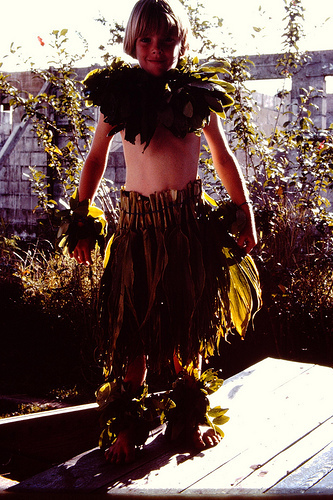
Every year, there were festivals at which all the schoolkids dressed traditionally and participated in dances. I don’t know this coincided with the festivals and symposiums at the University of the South Pacific, which was an important clearinghouse/repository of information for that entire area, across many different cultures.
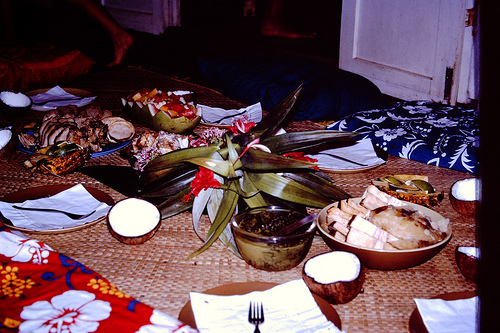
Spread for a meal…dalo, coconut, and more. Still makes my mouth water.
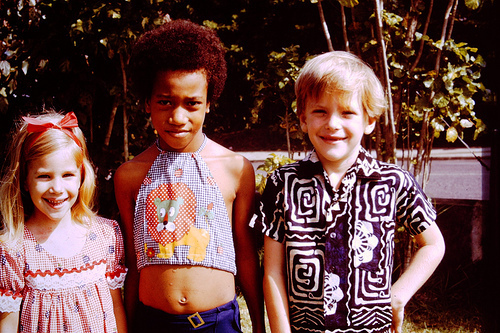
Elizabeth and me with a friend from the neighborhood.

Elizabeth contemplates a cracker.
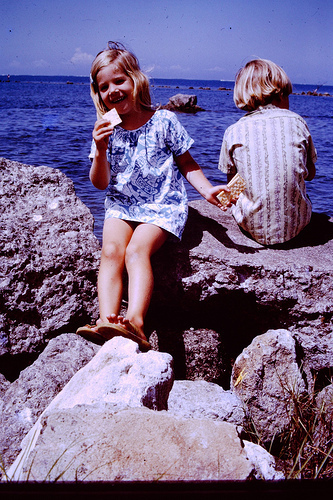
Something is cracking up Elizabeth.

Fiji is a volcanic island so there are mountains and it can get a little chilly up there.
ROMANIA
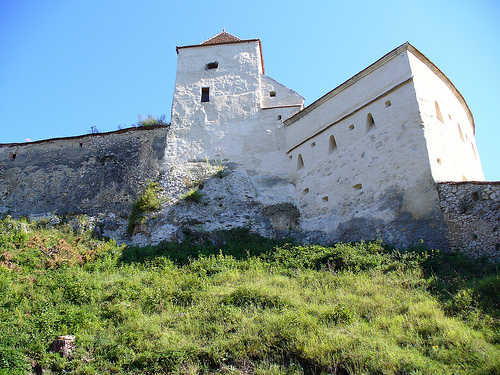
Monastery in central Romania, if I remember correctly. (Romanian photos by Michael Haulica and Bogdan Hrib.)
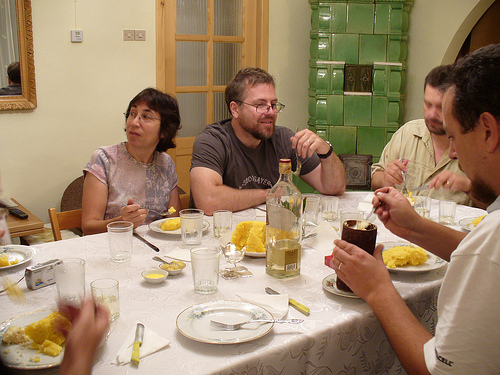
A great meal with great friends.
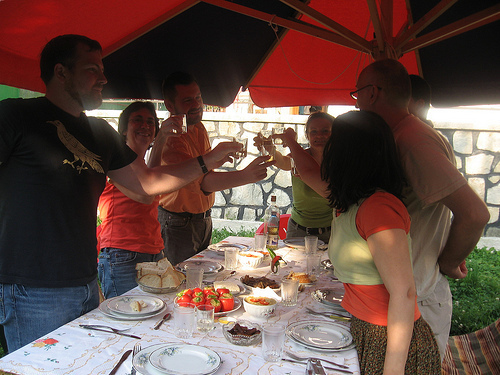
Many great meals, this one at a farmhouse.
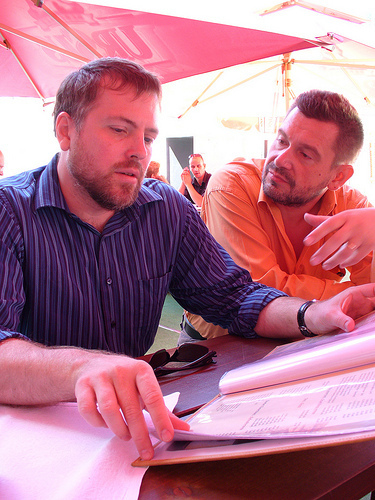
I like this shot of me and Bogdan, my publisher, quite a bit.

On the boat trip down the Danube…quite an experience.
SAN LUIS PARK

It’s wonderfully overgrown, foetid, humid, decaying forest…

And rotting logs! And more fungi! And snails!

After having lived in Florida over 25 years now, I feel most at home in this landscape, and I think that’s why it felt so natural and easy to write my new novel Annihilation, which is basically set in the wilderness of North Florida.
Photos from Fiji, Romania, and the Backyard… originally appeared on Ecstatic Days on August 25, 2012.




August 24, 2012
Cheeky Frawg Publishing Schedule
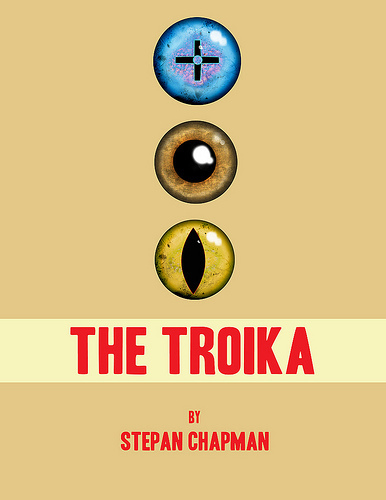
We’ve just finished finalizing most of the Cheeky Frawg schedule for 2012-2013—in addition to our already-released titles this year (in e-book form) of the anthology ODD?, Amal El-Mohtar’s The Honey Month, and Stepan Chapman’s Philip K. Dick Award-winning novel The Troika (in partnership with Wyrm/Ministry of Whimsy.) Please check all three of those great titles out. Not on the schedule below:
—Jess Nevin’s The Encyclopedia of Victoriana, a book for which we are partnering with Neil Clarke’s Wyrm imprint.
—Cruel Paris by Claude Seignolle (a collection newly translated by Gio Clairval), one of France’s most respected fantasists, for which we are considering doing a limited hardcover edition and some other special touches.
—The ODD? anthology series, for which a new schedule will be announced soon.
Late September 2012:
Don’t Pay Bad for Bad & Other Stories by Amos Tutuola—A selection of previously uncollected and rare tales by the Nigerian master storyteller. Blurbed by Nnedi Okorafor. Introduction by Tutuola’s son and afterword by Matthew Cheney. (E-book only.)
October 2012
Tainaron by Leena Krohn. This World Fantasy Award finalist short novel by one of Finland’s most highly regarded writers is a personal favorite of ours, and we’re delighted to be able to bring it back into print.
November 2012
Jagannath: Stories by Karin Tidbeck—This amazing collection by a wonderful Swedish writer has received glowing blurbs from the likes of Ursula K. Le Guin, China Mieville, Caitlin R. Kiernan, Karen Lord, and Karen Joy Fowler. Elizabeth Hand has written the introduction. We will have a book release party at the World Fantasy Convention in Toronto, with the author in attendance. Preorder links will be available in September. (Trade paper and e-book.)
April 2013
Datura by Leena Krohn—The increasingly strange story of the going’s-on at The New Anomalist magazine and a very dangerous flower. Another wonderful short novel by a Finnish icon. Instead of sections, the book comes in three seed pods. Newly translated by Juha Tupasela and Anna Volmari. Funded by a generous grant from the Finnish Literature Exchange. (Trade paper and e-book.)
May 2013
The Explorer & Other Stories by Jyrki Vainonen—One of Finland’s best short story writers, Vainonen writes in a fantastical mode with an underlying hint of the macabre or disturbing. Newly translated by Juha Tupasela and Anna Volmari. Funded by a generous grant from the Finnish Literature Exchange. (E-book and possible trade paperback.)
September 2013
Dona Quixote: The Leena Krohn Omnibus—One great volume collecting Krohn’s novels Tainaron, Dona Quixote, Gold of Ophir, and Pereat Mundus (never before published), along with newly translated short stories, essays about Krohn’s work, and a complete bibliography. A publishing event. (Trade paper and e-book.)
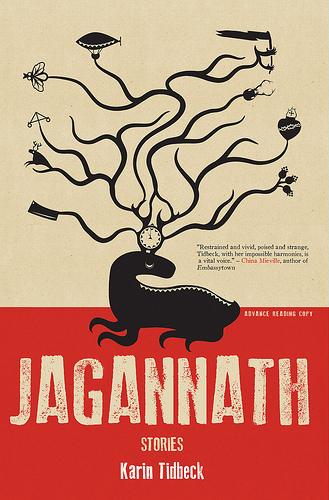
Cheeky Frawg Publishing Schedule originally appeared on Ecstatic Days on August 24, 2012.





